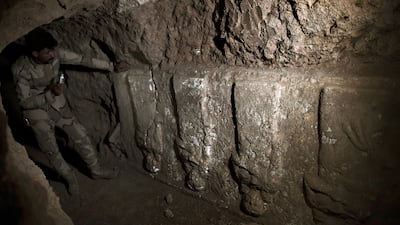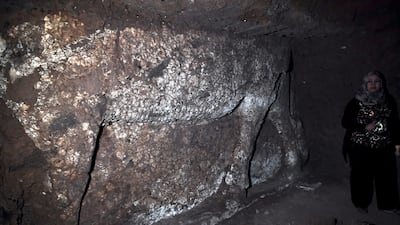It is as if the spirit of the past has reached out to the present.
In an awe-inspiring development, a joint Iraqi-German excavation team has brought pieces of history back to life in Iraq’s northern city of Mosul.
Two lamassus – mythical creatures with the body of a bull, the wings of an eagle and the head of a human being – were found at the site of a seventh-century BC Assyrian palace.
For centuries, the palace of the Assyrian king, Esarhaddon, who ruled for 12 years, was concealed despite evidence of its existence.
In the early 13th century, a mosque was built at the site believed to be the grave of the Prophet Jonah, known locally as the Prophet Yunis, mentioned in the Quran and the Hebrew Bible.
In 1924, a grand minaret was added by a Turkish architect, and in the 1980s and 1990s, Saddam Hussein renovated and expanded it, shrugging off calls to excavate the palace.
In July 2014 when ISIS overran the city, the mosque was blown up as part of a campaign to destroy archaeological and heritage sites, which the terrorist group considered pagan, and Islamic sites considered idolatrous.
After US-backed Iraqi security forces recaptured Mosul in July 2017, experts found a network of tunnels dug by the terrorists. Then, the artefacts became visible in photographs from the dark, crumbling labyrinth.
That paved the way for excavation in 2018 by German researchers from Heidelberg University.
“We removed the concrete surface from the bulls and they are now visible,” Khair Al Din Ahmed Nassir, head of the antiquities department in Nineveh province, of which Mosul is the capital, told The National.
They are among at least six others at the site, mainly at the Throne Hall, he said. Both bulls are headless.
“As a result for the expansion for Yunis mosques during the 1980s, parts of these bulls were removed when they prepared the ground [of the mosque],” Mr Nassir added.
“All the bulls are incomplete, mainly losing the heads. We hope we can find bulls with less damage. The rest will be visible soon."
The most important discovery at the site, he said, was a slab showing Assyrian girls. “This is the first time to have sculptures showing Assyrian girls clearly," he said.
The Assyrians first came to prominence about 2500BC and at one point ruled over a realm stretching from the Mediterranean coast to what is present-day Iran.
Their ancient buried cities, palaces and temples, laden with monumental art, are scattered across what is now northern Iraq and parts of neighbouring countries.
Thousands of Assyrian artefacts are on display at the Iraqi National Museum and elsewhere around the world. Others often appear at auction houses.
One of the Assyrians’ major artefacts is the lamassu. It dominated the headlines in 2015 when ISIS released a video showing the extremists blowing them up, using sledgehammers and drills to smash them into pieces.
ISIS also profited from them, stealing relics from palace walls or digging them out to sell on the international black market to finance their activities.
Mosul, Iraq's second-largest city, was the crown jewel of the extremist group’s self-declared caliphate. It was captured by ISIS during a lightning onslaught in mid-2014, which brought large parts of northern and western Iraq under its influence.
When the terrorist organisation was defeated and Mosul was reclaimed, foreign archaeologists poured into the city – joining their Iraqi counterparts from the US, UK, France, Germany and Italy – to uncover its rich history.
Some remarkable archaeological discoveries have been announced in the past two years in Mosul and the wider Iraq. Rebuilding work is under way at major sites such as Mosul museum, Al Nuri Mosque and several churches.
Iraq has nearly 25,000 known archaeological sites, most badly affected by decades of war, lack of security and mismanagement.
For decades, many of these sites were neglected. Closed to the public, they were poorly guarded and became an easy target for looters.
"Everything started here in Iraq; the principles of humanity and science, first writing, law, wheel, school and agriculture," archaeological researcher Amir Abdul-Razaq Al Zubaidi, told The National.
"But, unfortunately, the years of war and destruction have kept Iraq away from the scene of excavation and tourism."
These discoveries are not only uncovering the past, but also offering a glimmer of hope for the city’s residents as they gradually recover from the conflict.
With the security situation improving, foreigners to visit Mosul, but it was not always a positive experience, often associated with stories of death and destruction, tour guide Harith Firas told The National.
“At the beginning, tourists started to visit Mosul mainly due to the destruction it endured, in what is known as dark tourism,” Mr Firas, 24, said.
The student at the English translation department at the University of Mosul started as a tour guide in 2021, and with ongoing reconstruction, especially at many historical and heritage sites, tourists started to "compare the dark and bright sides of the city”.
But recent discoveries at the more prominent archaeological sites will further “encourage the tourists to come in big numbers and make the city a tourist attraction”, he said.
Mr Al Zubaidi said "Iraq is gradually regaining its well-being with significant leaps towards reviving tourism after all these discoveries".
"This will have a positive impact on economy and trade in Mosul and the whole of Iraq."



